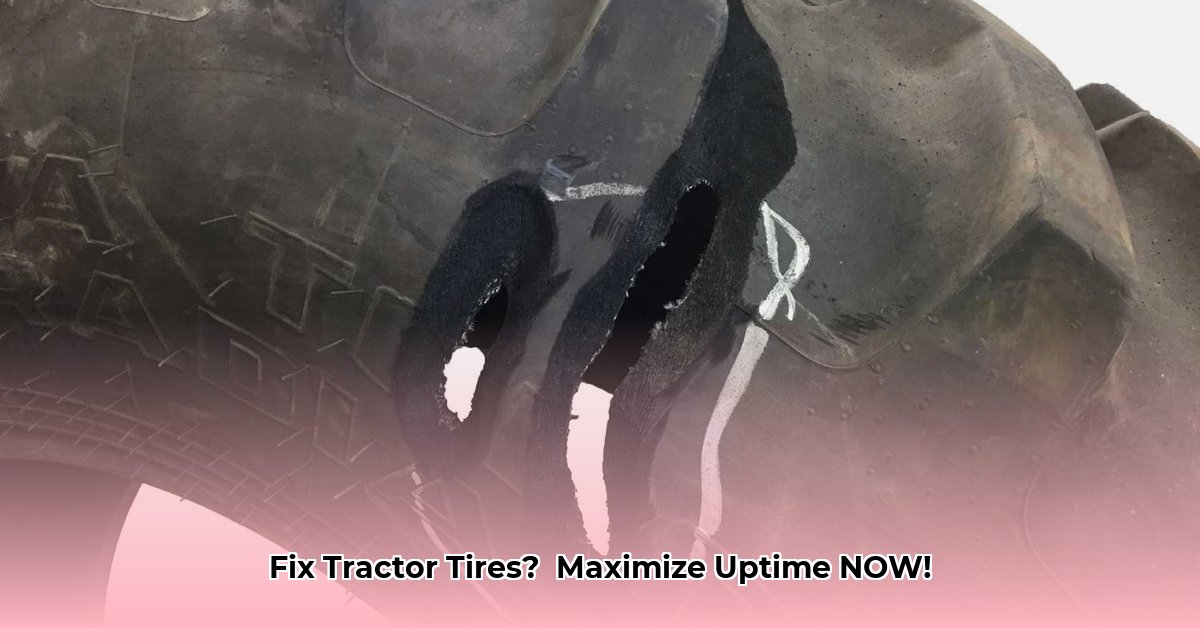
Keeping your tractor tires in top condition is paramount for efficient farm operations. Tire failures lead to costly downtime and lost productivity. This guide provides practical strategies for both repairing minor tire damage and implementing preventative maintenance to maximize tire lifespan. We'll explore vulcanization repair and preventative maintenance techniques, empowering you to make informed decisions about maintaining your tractor tires. For more info on inner tubes, see this helpful resource.
Vulcanizing Tractor Tires: A Quick Fix for Minor Damage
Vulcanization is a tire repair technique that uses heat and pressure to fuse a patch onto a damaged area, essentially "welding" the rubber back together. It's a cost-effective solution for small issues, but not a fix-all.
Types of Vulcanization Repairs
Vulcanization can address two main types of damage:
- Spot Repairs: Ideal for small punctures or tiny cuts. Think of these as a "band-aid" solution for minor tire damage.
- Section Repairs: Suitable for longer cuts running along the tire's length. These repairs are more involved but still achievable through vulcanization.
(Image: Illustrative photos of a spot repair and a section repair would be inserted here.)
When to Use Vulcanization – and When Not To
Vulcanization excels at fixing minor damage, offering a cost-effective alternative to full tire replacement. However, certain damage necessitates a new tire:
- Size Matters: Cuts larger than a few inches or those penetrating deeply usually require replacement.
- Sidewall Issues: Sidewall damage is extremely dangerous and almost always requires tire replacement. Vulcanizing a sidewall is strongly discouraged.
- Bead Proximity: Damage near the tire bead (where the tire meets the rim) is difficult to repair safely and often necessitates replacement.
Step-by-Step Vulcanization Repair Guide
Remember: Safety first! Always wear safety glasses and protective gloves.
- Clean Thoroughly: Remove all dirt, debris, and loose rubber from the damaged area using a suitable solvent. A clean surface ensures optimal patch adhesion.
- Prepare the Surface: Roughen the area around the damage with sandpaper or a wire brush to improve the patch's bond. This increases the repair's strength and durability.
- Apply the Patch: Carefully position the vulcanizing patch, adhering to the manufacturer's instructions. Ensure complete coverage of the damage and a snug fit.
- Cure the Patch: Apply heat and pressure using a heat gun or vulcanizing press, following the patch instructions meticulously. This crucial step fuses the patch and the tire's rubber, creating a lasting repair.
- Inspect Carefully: After cooling, check the repair for air leaks. Inflate the tire to the recommended pressure and carefully examine the patch area for any escaping air.
Necessary Tools and Materials
- Vulcanizing patch kit (select the appropriate type for your tire and damage)
- Heat gun or vulcanizing press (a press provides more even heat distribution)
- Rubber-compatible cleaning solvents
- Sandpaper or wire brush
- Safety glasses and protective gloves
Troubleshooting Vulcanization Repairs
If your repair fails, several factors may be at play: improper patch application, excessively severe damage, or inadequate curing. Review the steps and assess the severity of the damage to determine the best course of action.
Preventative Tire Maintenance: A Proactive Approach
Preventative maintenance is the most cost-effective way to maintain your tractor tires. Regular inspections prevent significant damage from developing, avoiding costly repairs or replacements.
Regular Tire Inspections: A Checklist
Conduct regular inspections to promptly identify and address potential problems:
| Item | What to Check For | Action |
|---|---|---|
| Tire Pressure | Low pressure, slow leaks, uneven pressure | Inflate to recommended pressure; repair leaks |
| Sidewalls | Cuts, bulges, cracks, unusual wear patterns | Repair minor damage; replace if severe |
| Tread Depth | Worn tread, uneven wear, cuts in the tread | Replace when tread is too low or unevenly worn |
| Overall Condition | Any unusual wear, damage, or abnormalities | Address issues immediately; plan replacements if needed |
Air Pressure Management: The Foundation of Tire Health
Maintaining correct tire pressure is crucial. Underinflation leads to excessive wear, while overinflation can cause damage and premature failure. Always consult your tractor's manual for specified pressures and consider a Tire Pressure Monitoring System (TPMS) for convenient, continuous monitoring.
Don't underestimate the importance of proper inflation – wouldn't you want to prevent a costly tire blowout?
Additional Preventative Measures
- Foam Filling: Consider foam-filling your tires for enhanced puncture resistance.
- Proper Storage: Protect tires from sunlight and extreme temperatures during storage.
- Driving Habits: Avoid harsh driving conditions (excessive speed, sharp turns, rough terrain).
Creating a Preventative Maintenance Schedule
Develop a maintenance schedule tailored to your farm's needs and conditions:
- Weekly: Quick visual inspection; pressure check.
- Monthly: Thorough inspection using the checklist above.
- Annually: Professional inspection; necessary replacements or repairs.
Choosing Between Repair and Preventative Maintenance: A Cost-Benefit Analysis
The optimal approach combines both vulcanization repair and preventative maintenance. Preventative care minimizes the likelihood of severe damage, while vulcanization offers a cost-effective solution for handling minor problems expediently.
Cost Comparison: Vulcanization vs. Preventative Maintenance
| Feature | Vulcanization | Preventative Maintenance |
|---|---|---|
| Upfront Cost | Low (patch kit and materials) | Moderate (inspection time, potential materials) |
| Time Investment | Relatively quick | Ongoing, but preventative |
| Effectiveness | Effective for minor damage; limited for severe | Prevents major issues; minimizes repair needs |
| Long-Term Cost | Potentially higher with repeated repairs | Lower overall; prevents many repairs |
By combining these two strategies, you significantly extend tire life, reduce downtime, and improve your farm's efficiency and profitability. A little preventative maintenance can save you a substantial amount in the long run. Isn't that a worthwhile investment?